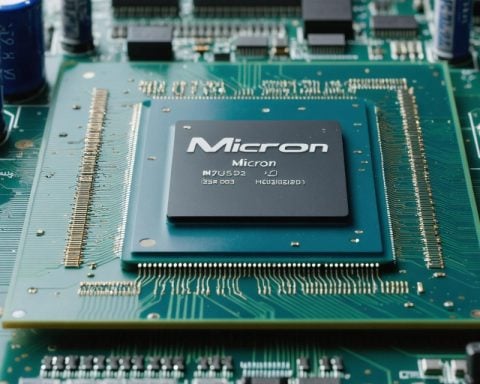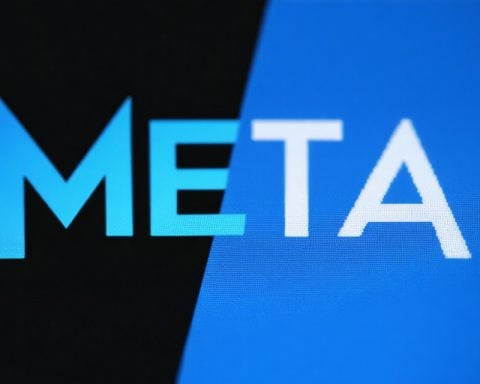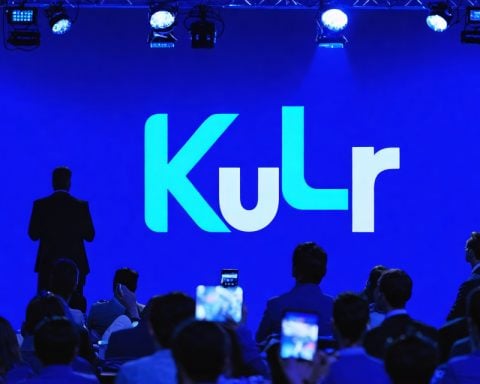- Microsoft unveils the quantum computing chip Majorana 1 featuring a novel topological superconductor.
- The chip aims to pack the power of a million qubits into a handheld device, advancing quantum computing capabilities significantly sooner than anticipated.
- Chetan Nayak highlights Microsoft’s goal to overcome current quantum technology limitations with this innovation.
- The launch sparks increased investor interest, boosting stocks for companies like IONQ, Rigetti Computing, and Quantum Computing.
- Microsoft’s effort could transform quantum computing from a scientific curiosity into a tool with vast industrial applications.
- This development could redefine digital possibilities by leveraging the smallest particles in the universe for significant progress.
Stepping boldly into the future of technology, Microsoft has unveiled its latest creation—a quantum computing chip named Majorana 1. This isn’t just any chip; it’s crafted with a novel ingredient: a topological superconductor, an exotic state of matter that defies traditional classification. In essence, Microsoft has birthed a new quantum transistor for the digital age.
The ambition behind this innovation is staggering—Microsoft aims to compress the power of a million qubits into a device that fits snugly in your palm. This vision could catapult quantum computing capability from a curious exploration to a revolution in industrial applications, reaching maturity not in centuries, but potentially in mere years. A technological dream that once seemed light-years away now feels almost within grasp.
Chetan Nayak, a leading mind at Microsoft, elucidates the goal: to leapfrog the technological hurdles that limit current quantum endeavors. With this new chip, Microsoft may have found the key to expand past the looming ceiling of current technology.
This announcement sent ripples through the financial waters, igniting investor interest across the quantum sector. Stocks for companies like IONQ, Rigetti Computing, and Quantum Computing all witnessed notable jumps as hopeful investors speculated on the next big thing in tech.
With a chip that defies the norm and aspirations that reach for the stars, Microsoft underscores an essential impulse: harness the smallest particles in the universe to unlock the largest potential for human progress. Here lies the promise of quantum computing—a shift that could redefine what’s digitally possible.
The Quantum Leap: Microsoft’s Majorana 1 Chip Revolutionizes Computing
How-To Steps & Life Hacks
While quantum computing is still largely in the realm of research and development, understanding its potential starts with familiarization:
1. Start with the Basics: Grasp fundamental principles of quantum mechanics, focusing on qubits, superposition, and entanglement.
2. Programming Skills: Languages like Q# by Microsoft and Python libraries such as Qiskit from IBM are essential for programming quantum computers.
3. Stay Updated: Follow the latest research and development news in quantum technology to stay proactive with new opportunities.
4. Join Communities: Engage in forums and groups like the Quantum Computing Stack Exchange to gain insights and share knowledge.
Real-World Use Cases
Quantum computing holds enormous potential in:
– Cryptography: Enhances security by developing unbreakable codes and algorithms.
– Drug Discovery: Simulates molecular structures to identify new pharmaceutical compounds more efficiently.
– Optimization Problems: Solves complex logistical problems such as route optimization.
– Financial Modeling: Improves risk analysis and predictions in financial markets.
Market Forecasts & Industry Trends
According to recent reports, the quantum computing market is projected to grow from $472 million in 2021 to $1.76 billion by 2026, a CAGR of 30.2% Grand View Research.
Reviews & Comparisons
Currently, Microsoft faces competition from:
– IBM: Leads with its accessible cloud-based quantum computing services.
– Google: Achieved a significant quantum supremacy milestone with its Sycamore processor.
– D-Wave: Known for its annealing-based quantum processors tailored for optimization problems.
Controversies & Limitations
Some limitations and controversies surrounding quantum computing include:
– Error Rates: High computational error rates require advanced methods to manage, such as quantum error correction.
– Resource Demand: Requires extensive physical resources and cooling systems—posing challenges for energy sustainability.
– Security Concerns: Risk of current public-key cryptosystems becoming obsolete.
Features, Specs & Pricing
While exact specs of the Majorana 1 remain proprietary, key features include:
– Topological Superconductor: Promises a more stable qubit that resists quantum decoherence.
– Scalable Architecture: Designed to potentially incorporate millions of qubits.
Security & Sustainability
Microsoft aims to address:
– Energy Efficiency: Developing solutions to minimize the environmental impact of quantum processing.
– Quantum Encryption: Future-proof security systems to withstand quantum attacks.
Insights & Predictions
Experts predict that within 5 to 10 years, quantum computing will address complex problems inaccessible to classical computers, transforming industries like pharmaceuticals and logistics.
Tutorials & Compatibility
Follow Microsoft’s official quantum computing platform, Azure Quantum, for resources, tutorials, and access to their ecosystem.
Pros & Cons Overview
Pros:
– Potential to surpass current computational limits.
– Accelerated progress in research areas.
Cons:
– High costs and limited current practical applications.
– A steep learning curve for new entrants to the field.
Actionable Recommendations
– Continuous Learning: Regularly upgrade your knowledge and technical skills to adapt to new quantum advancements.
– Network Expansion: Build connections with industry experts through academic conferences and professional groups, leveraging platforms like LinkedIn.
By getting hands-on experience with technologies such as cloud-based quantum computing platforms, you can start adapting to and anticipating future quantum computing opportunities.




















